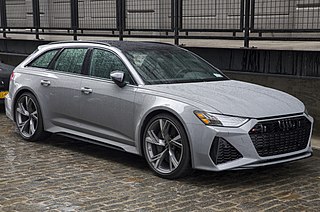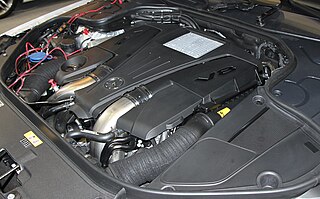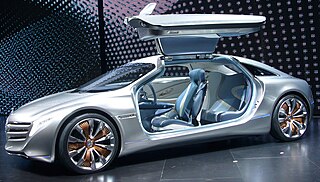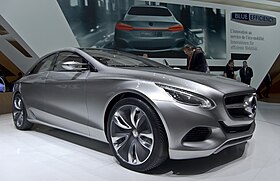
The Mercedes-Benz W201 is the internal designation for the Mercedes 190 series sedans, a range of front-engine, rear drive, five passenger, four-door sedans manufactured over a single generation, from 1982 to 1993 as the company's first compact class automobile.

The Audi Q7 is a crossover SUV made by the German manufacturer Audi, unveiled in September 2005 at the Frankfurt Motor Show. Production of this seven-seater SUV began in the autumn of 2005 at the Volkswagen Bratislava Plant in Bratislava, Slovakia.

The Audi RS 6 is a high-performance variant of the Audi A6 range, produced by the high-performance subsidiary company Audi Sport GmbH, for its parent company Audi AG, a subsidiary of the Volkswagen Group, from 2002 onwards.

The Porsche Panamera is a mid to full-sized luxury car manufactured and marketed by German automobile manufacturer Porsche. It currently spans across three generations, using a front-engine, rear or all-wheel drive configuration.

The Volkswagen Golf Mk5 is a compact car/small family car manufactured and marketed by Volkswagen, as the fifth generation of the Golf in three- or five-door hatchback and a five-door station wagon (2007–2009) configurations, as well as the successor to the Golf Mk4. Using the Volkswagen Group A5 (PQ35) platform, the Mk5 debuted at the Frankfurt Motor Show in October 2003 and went on sale in Europe for the 2004 model year. While marketed as the Volkswagen Rabbit in the United States and Canada, the GTI model in these countries was marketed simply as the Volkswagen GTI.

The Mercedes-Benz Vito is a mid-sized light commercial vehicle (LCV) produced by Mercedes-Benz, available as a panel van, chassis cab, or multi-purpose vehicle (MPV), carrying cargo or up to eight passengers. In the Mercedes-Benz van lineup, it is positioned between the larger Sprinter and the smaller Citan.

Audi hybrid vehicles are hybrid electric vehicles created by the German carmaker, Audi. Some vehicles listed were concept vehicles, which utilised an internal combustion engine and an electric motor, and were used for research and development (R&D) for potential future use of the technology into possible series production. Audi launched its first hybrid concept car in 1989 called the Audi Duo, and was the first European company to sell a hybrid in 1997, though only in very small numbers.

The Elect'Road is a plug-in series hybrid version of Renault's popular Kangoo. Sales began in Europe in 2003, mainly in France, Norway and a few in the UK. The Elect'Road was sold alongside Renault's Electri'cité electric-drive Kangoo battery electric van. Renault discontinued the Elect'Road after selling about 500, primarily in France, Norway and the UK, for about €25,000.

The Mercedes-Benz BlueZERO concept is Mercedes' attempt at the alternative fuel vehicle movement. The BlueZERO is a flexible concept that has the ability to accommodate the three different types of future alternative fuels: electric, hybrid, and hydrogen fueled. It was first introduced at the 2009 Detroit Auto Show which took place January 11–25. It features a single vehicle architecture that accommodates three models with different electric power-train configurations, each of which are fully developed and ready for testing. The Mercedes-Benz BlueZERO electric drive system gives each model the same performance specifications for acceleration and top speed. The Mercedes-Benz BlueZERO electric drive modular design accelerates from 0 to 100 km/h (62.5 mph) in under 11 seconds, and the top speed is electronically governed to 150 km/h (93 mph) in the interests of optimal range and energy efficiency. Peak torque is 320 N⋅m (236 lb⋅ft) and as with all EVs, maximum torque is available from zero rpm.

The Porsche 918 Spyder is a high performance sports car manufactured by German marque Porsche. The 918 Spyder is a plug-in hybrid powered by a mid-mounted naturally aspirated 4.6 L (4,593 cc) V8 engine, developing 447 kW at 8,700 RPM, with two electric motors delivering an additional 210 kW for a combined output of 652 kW (875 hp) and 1,280 N⋅m (944 lbf⋅ft) of torque. The 918 Spyder's 6.8 kWh lithium-ion battery pack delivers an all-electric range of 19 km (12 mi) under the US Environmental Protection Agency's five-cycle tests.

The Mercedes-Benz M278 is a family of direct injected, Bi-turbocharged, V8 gasoline automotive piston engines.

The Mercedes-Benz F125 is an electrically driven, hydrogen fuel cell concept car unveiled at the 2011 Frankfurt Motor Show. It is named 125 to celebrate the 125th anniversary of Mercedes-Benz.

The Mercedes-Benz W205 is the fourth generation of the Mercedes-Benz C-Class which was produced by Daimler AG between 2014 and 2021. The W205 C-Class was preceded by the W204 C-Class and superseded by the W206 C-Class. The fourth-generation C-Class was available in sedan (W205), station wagon/estate (S205), coupe (C205), cabriolet (A205) and long-wheelbase sedan (V205) body styles.

The W213 Mercedes-Benz E-Class is the fifth generation of the Mercedes-Benz E-Class, sold from 2016 as a 2017 model. It succeeded the W212/S212 E-Class models. The coupe/convertible models share the same platform as the sedan/wagon, in contrast to the previous generation. The high-performance Mercedes-AMG E 63 and E 63 S versions of the W213 have been available as well from 2016, and these are the only versions with V8 engines.

The Audi Q8 is a mid-size luxury crossover SUV coupé made by Audi that was launched in 2018. It is the flagship of the Audi SUV line, and is being produced at the Volkswagen Bratislava Plant.

The Mercedes-AMG ONE is a limited-production plug-in dual hybrid sports car manufactured by Mercedes-AMG, featuring Formula One-derived technology. The Project One concept car was unveiled at the 2017 International Motor Show Germany by the then three-time F1 world champion and Mercedes-AMG Petronas F1 driver, Lewis Hamilton and head of Mercedes-Benz, Dieter Zetsche.

The BYD Han is a full-size sedan (E-segment) manufactured by the Chinese manufacturer BYD Auto since 2020. It is a flagship model of BYD's "Dynasty Series" passenger vehicles, and was named after the Han Dynasty, the first golden age of Imperial China. Since its introduction, the Han has been available as a battery electric vehicle marketed as Han EV and plug-in hybrid variants.

The Mercedes V6 hybrid Formula One power unit is a series of 1.6-litre, hybrid turbocharged V6 racing engines which features both a kinetic energy recovery system (MGU-K) and a heat energy recovery system (MGU-H), developed and produced by Mercedes-AMG High Performance Powertrains for use in Formula One. The engines were in use since the 2014 season by the Mercedes works team. Over years of development, engine power was increased from 630 kW (840 hp) at 15,000 rpm, to 770 kW (1,030 hp) at 15,000 rpm. Customer team engines were used by Williams, McLaren, Lotus, Manor Racing, Force India, Racing Point Force India, Racing Point and Aston Martin. Their most recent championship victories are in 2020 (Drivers') and 2024 (Constructors').

The Hyundai Vision FK is a concept car that uses a plug-in hybrid drivetrain with both a large traction battery and a hydrogen fuel cell; the concept vehicle was developed by Hyundai and Rimac Automobili. The mid-motor, rear-wheel-drive sports coupe was unveiled at the Hydrogen Wave Forum in September 2021, an event organized by Hyundai to outline its plans to popularize hydrogen vehicles by 2040 for "Everyone, Everything and Everywhere". Power is delivered through two electric traction motors, both on the rear axle. The Vision FK can be plugged in to recharge its traction battery, which has more than 60 kW-hr of energy storage capacity, and the onboard fuel cell affords it a range greater than 600 km (370 mi).




















